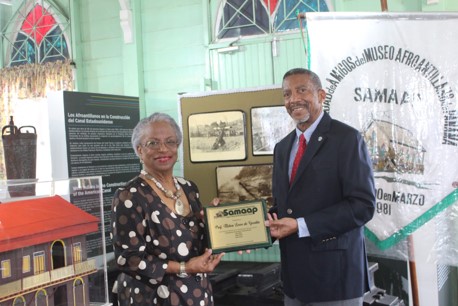Celebrating 40 Years of La Sociedad de Amigos del Museo Afroantillano de Panamá

La Sociedad de Amigos del Museo Afroantillano de Panamá (SAMAAP) is a non-profit organization that supports the West Indian Museum of Panamá, a government-run museum located in the town of El Marañón, in Panamá City, Republic of Panamà. Melva Lowe Goodin, was SAMAAP’s first president and a founding member and Arcelio Hartley is the current president of SAMAAP. The organization celebrated its 40th anniversary on March 24, 2021.
How does SAMAAP serve the West Indian Museum of Panamà, Panamà’s Afrodescendant community, and the greater Panamanian society?
Melva Lowe Goodin: When we founded SAMAAP, our main goal was to support the government of Panama in making the Museum a dignified monument to the efforts of the thousands of West Indian workers who migrated to this isthmus to participate in the building of the Transisthmian Railroad and the Panama Canal. Over time, our shared experiences increased, and we were called upon to have greater involvement in the Afrodescendant community and the wider Panamanian society. Today, issues of racial discrimination remain at the forefront of our struggles.
Arcelio Hartley: SAMAAP raises funds that provide financial support for the maintenance of the Museum’s structure and its grounds, for example, repairing the entrance stairways, enhancing the parking area, expanding the administrative office and restroom facilities, providing air conditioners for the Museum and the office, and storage spaces for museography. The organization promotes the recognition of West Indians as key contributors to Panamá’s development; it cultivates pride in the black community and respect from the wider Panamanian society.
Arcelio, you are the current president of SAMAAP, and before that, you were on the Board for four years. How did you originally get involved with SAMAAP?
AH: I got to know of SAMAAP in 2003 when I was selected as an honoree at the annual “Conozca su Canal” gala fundraiser. That led to my participation in the memorial pilgrimage through the Panama Canal’s Gaillard Cut. I liked what the organization was doing and decided to get involved initially by helping to improve the transportation process for the Gaillard Cut pilgrimage and by assisting with the Afro-Caribbean Fair. Prior to my election as president, I served on the Board for four years; as Vice President from 2017 to 2018 and then as Law and Order Officer from 2019 to 2020.
Melva, it’s been 40 years since you first founded this organization along with fifteen other members of the West Indian community in Panamà. What were SAMAAP’s goals when you started the organization and how has it evolved over time?
MLG: It has been 40 years since a group of fifteen members of our Afro-Panamanian community came together to lay the groundwork for the organization that we now know as SAMAAP. At that time, our main goal was to keep the doors of the Museum open and to enhance its recognition within our country. We faced the task of educating the members of our community about the important role that museums play in maintaining culture and identity. Today, we have an active membership of several hundred residents of Panamà, the United States, and other countries. With the support of these members, we have been able to carry out important construction projects and cultural events.
What do you feel are some of SAMAAP’s most significant achievements?
MLG: SAMAAP’s most significant achievement is the support it lends to governmental agencies to enhance the structure of the Museum and its surrounding environment. Our participation in the curatorial aspects of the exhibits within the Museum has taught us a lot about our history and the personalities who made an impact during the early years of our immigration to Panamá. As a result of our enthusiasm, we have earned a significant degree of respect nationally and internationally, which is a source of great pride for us.
AH: Managing to maintain a significant number of people supporting the organization and remaining a relevant and respected group within the society for 40 years are both big accomplishments. It has organized a fair that has become a widely sought-after activity—not just among blacks but also the wider cross-cultural society.
What do you feel are some of the most pressing issues for the Museum today?
MLG: The most pressing issue for the Museum today is continuing the struggle to eradicate the persistent vestiges of racial discrimination that exist within the society; in so doing, our Museum will benefit from better government support. Much work must be done to educate the population about the role of people of African descent in Panamà’s development, as well as to train university students to carry out historical research so that our exhibits are continuously appealing. A conscientious effort must be made to encourage the consistent participation of young people in the organization.
AH: The preservation of the housing structure of the Museum, which is a wooden church built more than 110 years ago, is a pressing issue for our organization. Additionally, the formalization of the relationship between SAMAAP and the Ministry of Culture will guarantee the organization’s continued role in supporting the museum and promoting its appreciation within the community.
How do you envision the future of the West Indian Museum of Panamà and SAMAAP?
MLG: I would like to see SAMAAP continue its leadership role within the national and international communities as an organization that supports the human rights of people of African descent in all parts of the world. I would like to see us develop the capability to build and manage cultural centers that provide these communities with facilities to develop their talents and skills.
AH: I hope to see the museum become part of a larger cultural center that will serve to enhance the learning experiences, particularly of the black community. I am hopeful SAMAAP will remain a vital partner with the Museum and the government in order to safeguard the legacy of the West Indian contribution to Panamà.
Interview by Nyasha Warren
